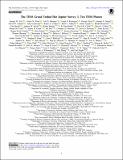The TESS Grand Unified Hot Jupiter Survey. I. Ten TESS Planets
Author(s)
Seager, Sara
DownloadPublished version (10.56Mb)
Publisher with Creative Commons License
Publisher with Creative Commons License
Creative Commons Attribution
Terms of use
Metadata
Show full item recordAbstract
Abstract
Hot Jupiters—short-period giant planets—were the first extrasolar planets to be discovered, but many questions about their origin remain. NASA’s Transiting Exoplanet Survey Satellite (TESS), an all-sky search for transiting planets, presents an opportunity to address these questions by constructing a uniform sample of hot Jupiters for demographic study through new detections and unifying the work of previous ground-based transit surveys. As the first results of an effort to build this large sample of planets, we report here the discovery of 10 new hot Jupiters (TOI-2193A b, TOI-2207b, TOI-2236b, TOI-2421b, TOI-2567b, TOI-2570b, TOI-3331b, TOI-3540A b, TOI-3693b, TOI-4137b). All of the planets were identified as planet candidates based on periodic flux dips observed by TESS, and were subsequently confirmed using ground-based time-series photometry, high-angular-resolution imaging, and high-resolution spectroscopy coordinated with the TESS Follow-up Observing Program. The 10 newly discovered planets orbit relatively bright F and G stars (<jats:italic>G</jats:italic> < 12.5, <jats:italic>T</jats:italic>
<jats:sub>eff</jats:sub> between 4800 and 6200 K). The planets’ orbital periods range from 2 to 10 days, and their masses range from 0.2 to 2.2 Jupiter masses. TOI-2421b is notable for being a Saturn-mass planet and TOI-2567b for being a “sub-Saturn,” with masses of 0.322 ± 0.073 and 0.195 ± 0.030 Jupiter masses, respectively. We also measured a detectably eccentric orbit (<jats:italic>e</jats:italic> = 0.17 ± 0.05) for TOI-2207b, a planet on an 8 day orbit, while placing an upper limit of <jats:italic>e</jats:italic> < 0.052 for TOI-3693b, which has a 9 day orbital period. The 10 planets described here represent an important step toward using TESS to create a large and statistically useful sample of hot Jupiters.</jats:p>
Date issued
2022Department
Massachusetts Institute of Technology. Department of Earth, Atmospheric, and Planetary SciencesJournal
Astronomical Journal
Publisher
American Astronomical Society
Citation
Seager, Sara. 2022. "The TESS Grand Unified Hot Jupiter Survey. I. Ten TESS Planets." Astronomical Journal, 164 (2).
Version: Final published version